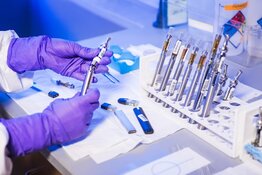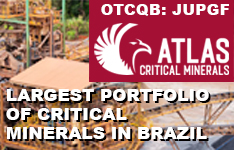The Life Sciences Report: The consensus is that biotech is on the upswing and that it may be a safer bet for investors than gold or energy at this point in time. Do you agree? Can you tell me why?
John McCamant: The numbers are big, in that biotech was the number one performing sector in 2012. It is up again this year. People are a little nervous about that, but the numbers don't lie.
What does that tell us? We've come a long way in the cycle, so biotech companies are much more mature. We have a better idea of what are better targets. There have been some significant advances. Now, "a safer bet" is an interesting idea. Obviously gold, energy and biotech are all high beta areas. One of the ways we think investors can manage a portfolio is through diversity. We cover some companies with actual products and sales, and some companies with more diverse portfolios. We recommend some companies that have pipeline technologies with multiple shots on goal, multiple chances to get different drugs to the market. When you add those up, yes, I think life sciences, and in particular healthcare, is a tremendous opportunity.
Then you can look at the broader picture. We have baby boomers advancing significantly in age, and other very wealthy populations throughout the world willing to pay for these types of products. At the end of the day, you don't need your gold and you don't need your car if you're dying of cancer. You may have some energy needs, but those are modest.
Going forward we think healthcare, and in particular biotech, is a classic growth sector, and we believe the next 10–15 years is going to be the golden era for life sciences.
TLSR: As editor of the Medical Technology Stock Letter, you provide updates on the biotech companies under your coverage, as well as alerts on potentially stock-moving data as it is released. How do you select the companies you follow?
JM: We publish twice a month, with lots of updates and alerts. As to how we select companies, at the end of the day, as much as we talk about science and technology and things that are sexy, it comes down to management. I am looking for unique individuals who cannot be put into a cookie cutter.
"We recommend companies that have pipeline technologies with multiple shots on goal, multiple chances to get different drugs to the market."
Biotech companies are extremely complex. There is the science, the drug development process, dealing with Wall Street, the fact that companies can generate losses for years. It is difficult. But we look for different types of validation. We run into different types of CEOs that have had success in other places. Of course, investors should look at the technologies and the opportunities, but unless really good people are up top, a company is not going to be able to take full advantage of these.
Basically, we want both sides of the coin. We want excellent management, but we also look at different types of technologies. A company has to have both, in our opinion, to be a successful investment.
TLSR: The companies that you follow run the gamut from vaccine platform technologies to cancer treatments, small molecules, biologics and treatments for mental illness. Do investors need to diversify as broadly?
JM: I believe so. I have 25 years of experience. My partner, Jay Silverman, has 25 years of experience. That experience makes it much easier to follow companies and put developments into perspective. At the end of the day, we follow Peter Lynch on that question. I would guess you know somebody with every affliction we have mentioned, as do I, whether it's inflammation or people with cancer, unfortunately. And let's not kid anybody, we all know people with mental illness. Literally, in the financial industry, you've got to be a little crazy.
"I think life sciences, and in particular healthcare, is a tremendous opportunity."
Opportunity can be anywhere. Fifteen years ago there was no such thing as an erectile dysfunction drug. The industry had a big win with Cialis and Viagra, etc. We're not big fans of the space, but that was an opportunity. We've done a lot of work with companies in rare diseases; those can be tremendous opportunities also. Investors need to think about whether they understand a particular opportunity and what's going on within a particular space. The drug development arena offers so many different opportunities that it's almost unlimited.
TLSR: Are there specific spaces in the life sciences that you think investors should be focused on right now?
JM: I've already mentioned some, but one of the things we've been talking about recently is platform technologies. We've been fans for years.
Sometimes platforms consist of adding polymers to drugs and creating different ways of creating extended-release products, as with Alkermes plc (ALKS:NASDAQ), which can be quite interesting. Or, the platform can be as cutting edge as Sangamo BioSciences Inc.'s (SGMO:NASDAQ), with its gene therapy technology, or Isis Pharmaceuticals Inc. (ISIS:NASDAQ) with its antisense technology.
Technologies that got investors interested 10–15 years ago have taken almost that long to be ready to deliver new drugs. When a technology has a platform component to it, investors are not stuck with a company's fate or fortune based on only one drug. Platform companies have multiple shots on goal, which can diversify the risk for investors as well as allow companies to do partnerships relatively early in the process to validate technologies and then keep products longer into development.
TLSR: Let's talk about opportunities in some of the spaces you've mentioned. Shall we start with oncology? One of the companies in this arena, Pharmacyclics Inc. (PCYC:NASDAQ), is on our 2013 Biotech Watchlist. Pharmacyclics' stock is up more than 70% from January to April 22. Why don't you tell us about that?
JM: Pharmacyclics is up a couple hundred percent from our original recommendation in January 2012 at $17, so it's a tremendous winner. It currently trades at almost $76 per share. We recently raised our buy limit because we think a lot of what is going on at Pharmacyclics isn't being fully recognized by Wall Street.
Probably number one is that the company is turning into a regulatory/U.S. Food and Drug Administration (FDA) poster child. It has already received three breakthrough therapy designations on its Bruton's tyrosine kinase inhibitor, ibrutinib (PCI-32765), which is being developed for treatment of B-cell malignancies such as mantle cell lymphoma and chronic lymphocytic leukemia.
Now, the conundrum surrounding breakthrough designations is that this is a new process, just started in January 2013. We already have fast track approval for drugs, which follows about six months after a submission. Wall Street doesn't know quite what to think of the breakthrough therapy designation, and it is very nervous that this process might not be quite as good as it could be.
"We're going to have ups and downs, but the next 15–25 years could be incredible for biotech investors."
We have a couple of insights. One of them is that Pharmacyclics' partner on ibrutinib, Janssen Biotech Inc. (a subsidiary of Johnson & Johnson [JNJ:NYSE]), has historically filed for early access for patients who can't get into clinical trials. Janssen typically does this about two months before it files for actual approval. The filing was made last month. In addition, the FDA is facing sequestration and major financial budgetary problems.
Breakthrough therapies really are beautiful things. They're basically something the FDA did in the late 1980s and 1990s, when it was processing some of the HIV drugs. It is a way to get a drug to patients who badly need it. It's literally no risk to the agency because it is saying, "Yes, some people may die either way, but we really feel this is good." Of course, companies have to follow up with the data.
We believe the drug will be approved by the end of Q3/13. Pharmacyclics is going to file this summer, and the FDA is going to rush it through in a couple of months. Wall Street is looking at an early 2014 approval. But this is going to happen sooner rather than later. We're excited about it.
The European Medicines Agency (EMA) has said it will explore the breakthrough designation as well; it looks as if the EMA will do that relatively soon. Ibrutinib will be on the market sooner over there. Then we will get off-label use. It is the safest cancer drug we've seen with incredibly efficacy. It will be a real benefit for the industry.
TLSR: What are the catalysts on the horizon?
JM: FDA approval, and we have American Society of Clinical Oncology (ASCO) abstracts that will be released on May 15. There is also the 2013 ASCO conference, which takes place from May 31 to June 4. We believe we will have FDA approval by the end of the third quarter. To be honest, that's as good a catalyst as you ever get in this space.
TLSR: Can you speak to opportunities in the vaccine space?
JM: Absolutely. We've covered Novavax Inc. (NVAX:NASDAQ) for more than a few years. The company's virus-like particle (VLP) technology is very interesting. Novavax is using recombinant technology to create extremely safe next-generation vaccines.
We currently produce most vaccines in eggs. With this virus-like particle technology, Novavax is able to create new vaccines much faster. It has a Biomedical Advanced Research and Development Authority (BARDA) contract, with more than $100 million ($100M) already committed ($179M potential in total), that is funding the company's work on seasonal and pandemic flu vaccines. When you get that kind of government money, it's nondilutive. It's very rare for investors to get more than $100M dollars from the government to fund a public investment.
"As much as we talk about science and technology and things that are sexy, it comes down to management. I am looking for unique individuals who cannot be put into a cookie cutter."
Then there is the new bird flu in China. There's been some concern that the world may have overacted to some of the swine flu and bird flu scares that popped up six to eight years ago. Being a student of history and knowing that an avian flu was the killer in 1918—the number one pandemic ever—this new one is very serious. It is a lethal bird flu. The estimate was that maybe five mutations took place for the previous bird flu to become one that could be transmissible from human to human. This new one may have already made three or four of those mutations. Whether or not it turns into a pandemic, which would be a horrifying thing, Novavax could potentially be a huge hedge against any portfolio. What happens with a pandemic is airports shut down overnight. We saw that with SARS. It's the only way to try to contain these things. It potentially gets really crazy, really fast.
Novavax's technology is very clean and scalable. The company has partnerships with the Koreans and the U.S. government. It has already sequenced the current bird flu and is preparing to create a vaccine. It already has seasonal flu vaccines and the seasonal flu is a very strong business.
In addition, the company has released phase 2 data recently for a respiratory syncytial virus (RSV) vaccine, which is a very nice opportunity that no one has been able to tackle as of yet. There is a MedImmune drug called Synagis, a prophylactic treatment for RSV bought out by AstraZeneca plc (AZN:NYSE), with sales that peaked at about $1 billion. The vaccine is for preemies. Novavax is working on a strategy using pregnant mothers, where the pregnant mother is vaccinated and she transfers immunity to the newborn, and the phase 2 data was positive. In addition, the RSV vaccine has an opportunity in the elderly. Phase 1 trial data in this group is expected in this quarter.
Vaccines have been historically underappreciated, but particularly with the newer recombinant technologies I think they can be safer and also more effective. This is an emerging platform, with other opportunities in the space, like rabies. It's pretty broad-based, and very few companies have this type of technology.
TLSR: Can you talk about some of the other companies that you cover?
JM: Sure. Alkermes has been in the biotechnology space for many years. It is known as a drug delivery company and has used its polymer technology to create some blockbuster drugs, such as Risperdal Consta (risperidone) from Johnson & Johnson, a billion-dollar drug.
But when a company is the developer of the delivery technology it just gets a royalty, and doesn't actually own the drugs. This is Alkermes' business model. It has done a good job using that model, but is now transitioning to owning its drugs. The company recently put out some very impressive phase 2 data for a compound called ALKS 5461, for major depressive disorder (MDD). This is a very large opportunity; the drug has a different mechanism of action and is a wholly owned product for Alkermes.
We believe the company is making the transition. Alkermes originally started as a neurobiology company, but ended up making most of its hay by creating a platform technology. Now the company has taken this one step farther by taking products all the way through to phase 3 on its own, or by finding a partner for them. We expect Alkermes to have a good end of 2013. We recently raised our buy limit to $30 and our target price is $45.
TLSR: Is there another company you'd like to mention?
JM: Let's talk about Incyte Corp. (INCY:NASDAQ). Two recent events are adding value that do not seem to have been fully factored into the company's valuation.
First, Pfizer Inc.'s (PFE:NYSE) arthritis drug, Xeljanz (tofacitinib citrate), which was approved in the U.S., was turned down in Europe recently because there's some toxicity associated with it. It's an effective drug, but the effectiveness may not be balanced out by the toxicity. It is what's called a pan-JAK inhibitor; it inhibits three types of the JAK kinases, JAK 1, 2 and 3.
Incyte has a competing drug that only hits JAK 1 and 2. Jakafi is a cancer drug for myelofibrosis (MF). Incyte has another molecule, baricitinib, in phase 3 for rheumatoid arthritis (RA), that could compete with the Pfizer drug if the data's good, which we believe it will be.
Again, the drug doesn't target JAK 3. We think this could avoid a lot of the toxicity problems associated with Pfizer's drug. In addition, Incyte has developed two additional JAK inhibitors, and announced the fourth one just last week. Because these therapies only target JAK 1, the company believes they may be more effective, and certainly safer.
"Platform companies have multiple shots on goal, which can diversify the risk for investors."
Incyte is looking to be the leader in what is an underappreciated space. Incyte is not a pure platform company, but it is creating a lot of shots on goal with its small molecule team. It knows how to create different molecules around the same target, which are very similar but address different conditions. That allows the company to sell the therapies at different prices. The cancer market, and a chronic market like RA, have very different price points, i.e., one therapy might sell for $20,000 ($20K) a year and the other in excess of $100K a year. Having different molecules that do similar things, but are differentiated, is a very important strategy in the drug development business.
TLSR: You cover another company that's on our 2013 Biotech Watchlist, Sangamo BioSciences. Its stock was up 40% as of April 22. Would you like to comment?
JM: It was up more than that. It went from $6 to $8/share, and was as high as $11 recently.
Basically Sangamo is poised to report some HIV data at the American Society of Gene & Cell Therapy in Utah. The company has a very interesting technology and potentially can create a stronger, sustainable immune system, which some people believe can be a functional cure. These are very complicated trials. It looks like short-sellers or naysayers have already taken advantage, and the stock has been under a lot of pressure.
We think Sangamo is going to be a leader in gene therapy, particularly in monogenic diseases where just one gene, and one gene only, is changed. The technology is very precise and is something that the FDA is going to be very comfortable with.
The company has executed very well in so far as it has partnerships, has moved other early-stage programs forward, and some of the technology it described at last year's American Society of Hematology conference looks very promising. The bigger picture looks very good at Sangamo. Near term, we have gyrations in the stock price around some of the HIV data, which it will be presenting in the next week or two at a gene therapy meeting. HIV is a very complicated disease, and increasing the immune system also can be a little tricky. We look forward to data readouts, but we know that other good things are going on at Sangamo, regardless of the near-term gyrations.
TLSR: Are there any other companies you'd like to mention?
JM: Well, the worm has turned very nicely for us with Coronado Biosciences (CNDO:OTCBB). That was our number one pick for the year, as we talked about at the Biotech Showcase panel in January.
Coronado has picked up this incredible CEO, Dr. Harlan Weisman, who comes from the old Centocor and then Johnson & Johnson, and literally led development of the blockbuster drug Remicade (infliximab; Janssen Biotech Inc.), one of the most successful autoimmune drugs ever. Remicade has been approved for ulcerative colitis and many of the other autoimmune disorders that Coronado is targeting.
"Vaccines have been historically underappreciated, but particularly with the newer recombinant technologies I think they can be safer and also more effective."
We think the company's doing very well. It continues to add very good personnel. We have phase 2 readouts due out this year. We're very excited. Wall Street has had multiple recommendations, the most recent at about $10/share. My limit is $8 right now. If the data is positive, this stock breaks $20 very easily and the company would have multiple partnership opportunities. If the therapy works in one of the targeted autoimmune diseases, given the whole rationale and the theory behind hygiene hypothesis, it will work in most of them.
And the beauty of the therapy is that it is extremely safe. You just don't get a safer compound than what Coronado has created with a small parasite, the pig whipworm, which has been thoroughly researched and understood. It is totally benign. It's administered with a glass of water every two weeks and the main complaint is a teeny bit of salty taste. Done.
Paradigm shifting, whatever you call it—this is probably as big as it gets. The company probably wouldn't have this valuation if so many people weren't saying, "A worm? Are you kidding me?"
TLSR: Well, it does have a bit of that. . .
JM: It's a pig worm, of course. There's no question. But never say never. Who knows? The hygiene hypothesis states that the current lack of exposure to microbes in developed countries leads to a lack of autoimmunity. In direct contrast, in undeveloped countries there is almost no autoimmune disease. We are talking about multiple sclerosis, and even autism. This is potentially a very large drug opportunity. To be honest, the worm is potentially the largest drug in history. It could make Lipitor look like chump change. That just reduces a little cholesterol. This would change people's lives. It's the big stuff.
TLSR: Do you have any parting thoughts for our readers?
JM: Well, full circle is you never know where the opportunity is in biotech. We have 50 years of combined experience, my partner and I, and we're not going to get all of them. But we're going to get lots.
Real opportunity exists out there in biotech. There are better companies with better drugs, better targets, better regulatory controls. We're going to have ups and downs, but the next 15–25 years could be incredible for biotech investors.
TLSR: I really appreciate your time.
JM: You're welcome and my pleasure.
John McCamant is the editor of the Medical Technology Stock Letter, a leading investment newsletter in August 2000. McCamant has spent 25 years on the frontlines of biotechnology investing. McCamant has established an extensive network that includes contacts throughout the investment banking and venture capital communities. His expertise in biotechnology investments is a subject of media interest. He is frequently consulted and quoted by The Washington Post, Reuters, Bloomberg, CBS and Marketwatch.
Want to read more Life Sciences Report interviews like this? Sign up for our free e-newsletter, and you'll learn when new articles have been published. To see a list of recent interviews with industry analysts and commentators, visit our Streetwise Interviews page.
DISCLOSURE:
1) Tracy Salcedo-Chourré conducted this interview for The Life Sciences Report and provides services to The Life Sciences Reportas an employee. She or her family own shares of the following companies mentioned in this interview: None.
2) The following companies mentioned in the interview are sponsors of The Life Sciences Report: Johnson & Johnson. Streetwise Reports does not accept stock in exchange for its services or as sponsorship payment. Johnson & Johnson is not affiliated with Streetwise Reports.
3) John McCamant: I or my family own shares of the following companies mentioned in this interview: Novavax Inc., Incyte Corp. I personally or my family am paid by the following companies mentioned in this interview: None. My company has a financial relationship with the following companies mentioned in this interview: None. I was not paid by Streetwise Reports for participating in this interview. Comments and opinions expressed are my own comments and opinions. I had the opportunity to review the interview for accuracy as of the date of the interview and am responsible for the content of the interview.
4) Interviews are edited for clarity. Streetwise Reports does not make editorial comments or change experts' statements without their consent.
5) The interview does not constitute investment advice. Each reader is encouraged to consult with his or her individual financial professional and any action a reader takes as a result of information presented here is his or her own responsibility. By opening this page, each reader accepts and agrees to Streetwise Reports' terms of use and full legal disclaimer.
6) From time to time, Streetwise Reports LLC and its directors, officers, employees or members of their families, as well as persons interviewed for articles and interviews on the site, may have a long or short position in securities mentioned and may make purchases and/or sales of those securities in the open market or otherwise.














































